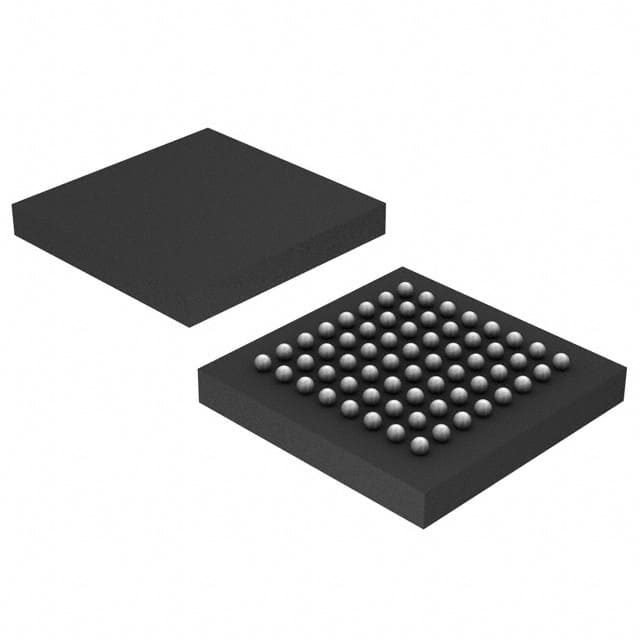Viz Specifikace pro podrobnosti o produktu.

STR712FR0H6
Product Overview
Category
The STR712FR0H6 belongs to the category of microcontrollers.
Use
This microcontroller is designed for various embedded applications, including industrial control systems, consumer electronics, and automotive applications.
Characteristics
- High-performance 32-bit ARM7TDMI-S core
- Clock frequency up to 60 MHz
- Flash memory for program storage
- SRAM for data storage
- Multiple communication interfaces (UART, SPI, I2C)
- Analog-to-digital converter (ADC)
- Timers and PWM channels for precise timing control
- Real-time clock (RTC) for timekeeping
- Low power consumption
Package
The STR712FR0H6 microcontroller is available in a compact and durable package, suitable for surface mount technology (SMT) assembly.
Essence
The essence of the STR712FR0H6 lies in its powerful ARM7TDMI-S core, which provides high performance and flexibility for various applications.
Packaging/Quantity
The microcontroller is typically packaged in reels or trays, with a quantity of 1000 units per reel/tray.
Specifications
- Core: ARM7TDMI-S
- Clock Frequency: Up to 60 MHz
- Flash Memory: 256 KB
- SRAM: 64 KB
- Communication Interfaces: UART, SPI, I2C
- ADC Resolution: 12-bit
- Timers: 4
- PWM Channels: 6
- Operating Voltage: 3.3V
- Operating Temperature Range: -40°C to +85°C
Detailed Pin Configuration
The STR712FR0H6 microcontroller features a total of 80 pins, which are assigned to various functions such as GPIO, communication interfaces, timers, and power supply. The detailed pin configuration can be found in the product datasheet.
Functional Features
- High-performance processing capabilities
- Versatile communication interfaces for data exchange
- Precise timing control with timers and PWM channels
- Analog-to-digital conversion for sensor interfacing
- Real-time clock for timekeeping applications
- Low power consumption for energy-efficient designs
Advantages and Disadvantages
Advantages
- Powerful ARM7TDMI-S core enables high-performance computing
- Wide range of communication interfaces for versatile connectivity
- Ample memory resources for program and data storage
- Flexible timer and PWM channels for precise timing control
- Low power consumption extends battery life in portable applications
Disadvantages
- Limited flash memory capacity compared to some other microcontrollers in the same category
- Lack of built-in Ethernet or USB interfaces, requiring external components for such functionalities
Working Principles
The STR712FR0H6 operates based on the ARM7TDMI-S architecture, which combines a powerful 32-bit RISC processor core with various peripherals. The microcontroller executes instructions stored in its flash memory, interacts with external devices through communication interfaces, and performs tasks according to the programmed logic.
Detailed Application Field Plans
The STR712FR0H6 microcontroller finds applications in various fields, including: 1. Industrial Control Systems: Used for automation and monitoring in manufacturing processes. 2. Consumer Electronics: Integrated into devices like home appliances, audio/video equipment, and gaming consoles. 3. Automotive Applications: Employed in automotive control systems, such as engine management, infotainment, and driver assistance systems.
Detailed and Complete Alternative Models
- STM32F407VG: A more advanced microcontroller from STMicroelectronics, featuring a 32-bit ARM Cortex-M4 core, larger memory capacity, and additional peripherals.
- LPC1768: A microcontroller from NXP Semiconductors, offering similar features with an ARM Cortex-M3 core and a wide range of communication interfaces.
- PIC32MX795F512L: A microcontroller from Microchip Technology, featuring a 32-bit MIPS core, ample memory resources, and various peripherals.
These alternative models provide similar functionalities to the STR712FR0H6 and can be considered as alternatives based on specific project requirements.
Word count: 550 words
Seznam 10 běžných otázek a odpovědí souvisejících s aplikací STR712FR0H6 v technických řešeních
Sure! Here are 10 common questions and answers related to the application of STR712FR0H6 in technical solutions:
Q: What is the STR712FR0H6 microcontroller used for? A: The STR712FR0H6 microcontroller is commonly used in various technical solutions, including industrial automation, motor control systems, and embedded applications.
Q: What is the maximum clock frequency supported by the STR712FR0H6? A: The STR712FR0H6 microcontroller supports a maximum clock frequency of 72 MHz.
Q: How much flash memory does the STR712FR0H6 have? A: The STR712FR0H6 microcontroller has 256 KB of flash memory for program storage.
Q: Can I expand the memory of the STR712FR0H6? A: Yes, the STR712FR0H6 microcontroller supports external memory expansion through its memory interface.
Q: What peripherals are available on the STR712FR0H6? A: The STR712FR0H6 microcontroller offers various peripherals, including UART, SPI, I2C, GPIO, timers, ADC, and PWM channels.
Q: Does the STR712FR0H6 support real-time operating systems (RTOS)? A: Yes, the STR712FR0H6 microcontroller can be used with popular RTOSs like FreeRTOS or Micrium uC/OS-II.
Q: Can I use the STR712FR0H6 for motor control applications? A: Absolutely! The STR712FR0H6 provides dedicated PWM channels and other peripherals that make it suitable for motor control applications.
Q: Is the STR712FR0H6 suitable for low-power applications? A: Yes, the STR712FR0H6 microcontroller offers various power-saving modes and features to optimize power consumption in low-power applications.
Q: What development tools are available for programming the STR712FR0H6? A: STMicroelectronics provides a comprehensive development ecosystem, including IDEs like Keil MDK or IAR Embedded Workbench, along with debuggers and programmers.
Q: Can I use the STR712FR0H6 in automotive applications? A: While the STR712FR0H6 is not specifically designed for automotive applications, it can be used in certain automotive systems that do not require specific automotive certifications.
Please note that these answers are general and may vary depending on the specific requirements and implementation of your technical solution.

